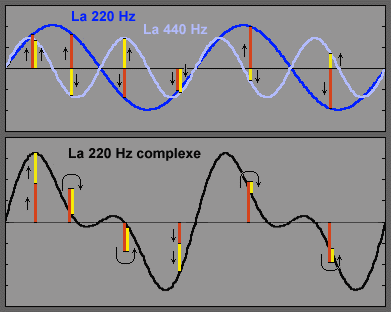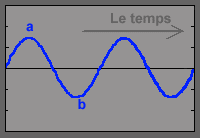Fourier Analysis
You're here : Audio >Learning


From the mathematician Joseph Fourier (18
th century) not to be mistaken with Charles Fourier (same period but
"Fourierism" theorician, the forerunner of "communism").
Roughly, Joseph demonstrates that any MUSICAL
sound (therefore, not noises), COMPLEX (therefore, not simple), with a frequency F, can be divided into an addition of SIMPLE sounds
(sinusoid : a sound produced by a mere oscillator, a beep) with their
HARMONICS with a frequency 2F then 3F, 4F....
In other words, if we play a simple A2 on
an organ, it's composed of :
-
A big amount of simple A2, the tonic, frequency F, that is 220 hz.
-
A small amount of simple A3 , the first harmonic, the octave, frequency 2F, that is 440 hz, which sounds like that after addition.
-
A small amount of simple E4, the second harmonic, the fifth, frequency 3F, that is 660 hz, which sounds like that after addition.
-
A small amount ofsimple A4, the third harmonic, the second octave, frequency 4F, that is 880 hz, which sounds like that after addition.
-
A small amount ofsimple C#5 , the fourth harmonic, the third, frequency 5F so 1100 hz, which finally sounds like that...
-
A small amount of E5, the fifth harmonic, the second fifth...and so on.....
The way all these "little bits" are
adjusted with their little friends actually determines an instrument's characteristics.
If we play an A3 on a guitar, it's
composed of the same harmonics as the organ but not with the same
distribution. For example with the organ, the fourth harmonic will only be
6 % of the tonic, whereas on the guitar, the fourth harmonic will be
27 % of the tonic. ( I don't know, I'm not sure, I said anything, it's
just an example...)
The first synthesizers were built following
this fantastic thought process.
We ask the oscillator to make a simple
silly sound, a 220 hz sinusoid. It is a Beep, it sounds
awful but it works.
Then it is asked to produce simultaneously
a 220-hz sinusoid plus another one at 440 hz but half stronger. It makes another beep
barely silly.
Then we complicate, we add harmonics,
follwing various distributions and the beep becomes richer and richer.
And if we take one distribution rather than another one, we manage to produce a
sound reminding us of a wind instrument (organ), or a string
instrument (violin),
or an instrument....Hum !
All of this makes the instrument's TONE.
Of course we have to add lots of things
to imitate the real instrument.
-
Sound produced while playing : finger noises on the guitar strings or the impact of piano hammers, or the opening of the register-door for the organ's pipe.
-
Change the sound over time : the sound of the organ is fairly constant when maintaining the finger on the key, whereas the sound of the piano dicreases quickly.
But Fourier, poor man, didn't have
Windows 95 ( Windows 1793 wasn't published yet ! ) or Cubase, so he didn't
know that one could put themselves out during hours with wonderfull bugs instead of playing
music calmly on his "pedal-lute" !
ADDITION OF SOUND
WAVE


|
First, a simple sound
wave, represented by a sinusoid. What does it mean ? For
example, look at the blue curve beside. It's a sinusoid. Imagine
that time passes along the horizontal black line around which
the sinusoid is represented.
| 
Note : the curve "goes up and down and up". We call "wavelength" the distance covered
by the sound during this time.
|
At a certain point, the curve is above
this axis (a), later it is below (b), and this alternately and
regularly, 220 times per second if the sound is a 220-Hz A.
And now, what does "adding two
sounds" mean ?

In the picture above, the blue sinusoid
is for example a 220-Hz Aand the light blue sinusoid, the 440-Hz A, the octave. .
You'll notice that the second curve goes up and down and up twice
faster than the first one. It's because it is a higher-pitched sound ! The addition
of these two waves makes the black wave below. Why does it have a more
complex shape than the first simple sinusoids ? It's because this one is
the addition, point by point, of the two curves. For some particular
points I've made red segments which show the first curve's height and a
yellow segment for the second curve's height. By simple addition when
both segments are in the same direction, they add to each other, upward or downward .
When they are opposed they substract from each other. It's all that simple !
The result is another 220-Hz A because his
main wavelength (tonic) is the same as the original 220-Hz A.
Compare the black curve and the dark blue curve : the action of the
second 440-Hz A (the first harmonic) simply modified the blue curve's
shape, the tonic.
Guy COULON, on the 17-12-1998

Page viewed 9924 times




